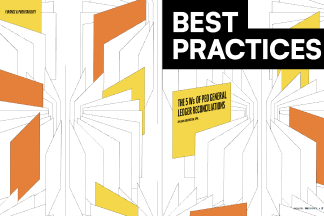OPTIMIZING PROFITABILITY BY MITIGATING CLAIMS COST AND CLAIM EXPOSURE
June/July 2024


In the dynamic realm of Professional Employer Organizations (PEOs), maintaining a competitive edge is paramount for sustaining profitability and ensuring superior value is delivered to your clients. Handling the specific challenges inherent with workers’ compensation insurance requires meticulous attention to detail. Reducing claim frequency and severity, controlling program expenses, and managing premium levels all present unique challenges.
This article explores strategies to ensure injured employees receive all the care, treatment, and benefits to which they are entitled within a system that controls associated costs and implements measures intended to mitigate future claim frequency. Taken together, these concepts are intended to strengthen a PEO’s workers compensation program, mitigate exposures, and enhance financial performance.
CLAIMS MANAGEMENT
Sound claims management is central to any workers’ compensation program’s operational efficiencies. The primary goal of a sound claims management operation is ensuring injured employees receive the care, treatment, and benefits to which they are entitled.
Timely and precise reporting and handling of claims not only ensures client satisfaction, but also mitigates financial liabilities. By having an in-house claims team and advocating for claims adjusters who maintain lower caseloads, PEOs can ensure thorough attention is given to each claim, leading to more expeditious and accurate assessments and resolutions. Robust claim reporting procedures have also proved effective in ensuring lag time is minimized and initial claim development goes unhindered.
Operational process efficiency is key, with streamlined workflows and clear protocols minimizing delays and errors. Proactive communication with clients and insurance carriers fosters transparency and trust. Clear channels of communication facilitate updates on claim status, resolution timelines, and any pertinent developments, enhancing client satisfaction and strengthening partnerships.
Additionally, leveraging data analytics offers invaluable insights into claims trends, patterns, and areas for improvement. Analyzing historical claims data enables risk assessment, facilitating proactive measures to mitigate future losses and optimize operational efficiency. This comprehensive approach to claims management not only enhances operational effectiveness but also contributes to long-term client retention and profitability through the creation of targeted pricing strategies for the PEO.
Key points to creating a reliable claims management program:
1. Timely and precise claims handling.
2. Streamlined workflows and clear protocols.
3. Active communication with insurance carriers and with clients.
4. The ability to analyze claims history by leveraging data analytics.
RISK MANAGEMENT
Risk management helps businesses protect their employees, preserve assets, minimize liabilities, and ensure sustainable growth. PEOs play a crucial role in offering comprehensive risk management services to their clients. By partnering with a PEO, businesses gain access to expertise in identifying, assessing, and mitigating various risks, including those related to employment practices, workplace safety, and regulatory compliance.
PEOs leverage their experience and resources to develop tailored risk management strategies that align with the unique needs and objectives of each client. From implementing safety protocols and training programs to navigating complex legal requirements, PEOs provide invaluable support in safeguarding businesses against potential threats and vulnerabilities. By proactively managing risks, businesses can enhance resilience, minimize disruptions, and achieve long-term success in today’s competitive landscape. By mitigating the onset and severity of workers’ compensation claims, risk management programs have a direct impact on lowering premiums and achieving a better experience modifier.
PEOs can help clients build a dependable risk management program by implementing the following key measures:
1. Create a risk identification culture – Be aware and identify hazards.
2. Develop a formal safety health program specific to the organization.
3. Standardize risk assessments, prioritize and manage accordingly.
4. Implement regular training to reinforce the company safety initiatives.
5. Measure results and build a continual improvement cycle.
SUBROGATION
Often overlooked, and frequently underutilized, an aggressive subrogation program helps PEOs recover those costs of a claim from the party responsible for the injury-causing event. Subrogation holds significant potential for cost recovery and premium mitigation.
Identifying subrogation opportunities promptly during claims investigation is paramount. The best subrogation programs align directly with the claims adjuster so that evidence is protected, and responsible parties identified. When accidents occur, it is imperative to identify the cause of an accident, accurately document the facts and circumstances, and move to preserve witness testimony and key pieces of evidence. Delays in identification can diminish the chances of successful recovery due to statute limitations or loss of evidence. Allocating dedicated resources or partnering with specialized subrogation experts enhances subrogation efforts.
Subrogation professionals possess a deep understanding of identifying potential subrogation opportunities, even in the most unlikely scenarios. Subrogation exists in virtually every situation; the critical factor lies in the experience to recognize it. Moreover, engaging a specialized partner to handle subrogation matters can lead to significant cost savings in the pursuit of claims. These experts are well-versed in the legal nuances of each jurisdiction, enabling them to identify liable parties and recover rightfully owed amounts. Additionally, subrogation specialists possess legal resources but exercise discretion in their utilization, prioritizing financial prudence. A reputable subrogation partner collaborates closely with clients to navigate the subrogation process, establish realistic expectations, and offer valuable insights to enhance the likelihood of favorable outcomes.
A robust subrogation program will likely have the following features:
- Real-time integration with the claims adjusting staff in order to protect and preserve critical information.
- Subrogation professional experienced in identifying responsible parties and finding root causes to accidents.
- Having access to legal resources in order to pursue responsible third parties.
SPECIAL INVESTIGATIONS UNIT (SIU)
Detecting and avoiding fraud in the underwriting, policy administration, or claims resolution process is another part of a PEOs cost-containment efforts in managing its workers’ compensation program. Fraud identification and mitigation is best handled through a Special Investigations Unit, or SIU group. An SIU group also helps safeguard PEO assets and upholds insurance program integrity.
Real-time detection of suspicious patterns enables proactive intervention, minimizes fraudulent activities and prevents, or limits, associated losses. Good SIU personnel also offer PEOs claims resources training with regards to fraud detection techniques, investigative procedures, and legal requirements, ensuring staff stay abreast of evolving fraud schemes and regulatory changes on a state by state basis.
The timely involvement of SIU resources significantly impacts the outcome of claims, as early intervention increases the likelihood of obtaining impactful evidence to influence the claim resolution. Furthermore, fostering cross-functional collaboration between the SIU, claims management, and legal teams optimizes fraud detection capabilities and investigative outcomes. Collaborative efforts expedite investigations, strengthen the case for prosecution, and deter future fraudulent activities.
Some traits associated with astute SIU practices include:
- Provide SIU personnel with real-time access to underwriting, policy, and claims data.
- Have SIU professionals with experience across a broad scope of insurance disciplines (underwriting, claims, etc.)
- Foster cross-collaboration between SIU personnel and PEO/Carrier personnel.
NURSE CASE MANAGEMENT
Nurse case management is instrumental in facilitating expedient and effective medical treatment for injured workers, thereby minimizing a PEO’s claim costs and expediting recovery. Implementing early intervention programs ensures prompt addressing of injuries and timely connection with appropriate medical care, preventing complications and reducing claim duration. Fostering collaborative care among nurse case managers, treating physicians, and other stakeholders optimizes treatment outcomes.
Clear communication and coordinated efforts facilitate adherence to medical protocols, minimizing unnecessary medical expenses and promoting efficient recovery. Continuous monitoring of treatment progress and outcomes enables proactive adjustments to the care plan. Data-driven insights facilitate timely interventions, ensuring optimal patient care and cost containment.
Must have characteristics of an effective nurse case management program include:
- Advocate on behalf of injured workers and employers alike, focusing on promoting recovery and a safe return to work.
- Remain vigilant throughout the lifespan of a claim, identifying opportunities for early intervention and potential complications throughout recovery.
- Employ knowledgeable medical professionals who understand how medical history, comorbidities, and other factors may impact the recovery process.
DRIVING SUSTAINABLE PROFITABILITY
In summary, control of a PEO’s workers’ compensation cost, and overall profitability of a PEO company’s operations hinges on astute management of critical areas such as claims administration, subrogation, SIU, risk management programs and nurse case management. By adhering to best practices tailored to each domain, PEOs and staffing companies can enhance operational efficiency, mitigate risks, and drive sustainable profitability in an increasingly competitive marketplace.
-
SHARE
- Copy to clipboard




